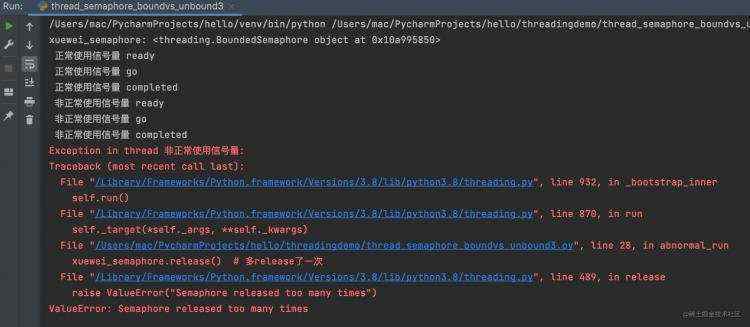作者:残念易_138 | 来源:互联网 | 2023-09-25 11:50
篇首语:本文由编程笔记#小编为大家整理,主要介绍了Python的线程14 有界信号量,这是一个有底线的信号量相关的知识,希望对你有一定的参考价值。
正式的Python专栏第51篇,同学站住,别错过这个从0开始的文章!
前篇学委提出了Semaphore信号量来制作限流器的思路和一个简单的限流器实现。
代码运行起来了,看起来没有错误。
不过,细心的读者会发现,如果我们出现像下面的信号量使用方式:
xuewei_semaphore.acquire() #获取信号量
//do something
....
xuewei_semaphore.release() #释放信号量
#>>> xuewei_semaphore.release() #如果这里再调用一次release呢?
也就是 Semaphore 进行的释放的操作,比获取的还多一点点,会不会出问题?
import threading
import time
xuewei_semaphore = threading.Semaphore(1)
print("xuewei_semaphore:", xuewei_semaphore)
def run():
print(" %s ready" % threading.current_thread().name)
xuewei_semaphore.acquire()
print(" %s go" % threading.current_thread().name)
time.sleep(0.1)
print(" %s completed" % threading.current_thread().name)
xuewei_semaphore.release()
def abnormal_run():
run()
xuewei_semaphore.release()
t = threading.Thread(name="正常使用信号量", target=run)
t.start()
time.sleep(1)
t = threading.Thread(name="非正常使用信号量", target=abnormal_run)
t.start()
上面学委结合了第一篇分享信号量的文章, 简化了一下,重点展示多释放信号量的效果。
我们发现程序没有任何报错:

如果我们把反常的使用增加调用呢,比如下面的代码:
for i in range(10000):
t = threading.Thread(name="非正常使用信号量"+str(i), target=abnormal_run)
t.start()
全程没有报错!!!

我直接震惊了!Python容错率太高了(这是高情商的说法,😂)
有界信号量 走过来把这个坑填上了
threading.BoundedSemaphore 这个类就是有界信号量,英文名非常直观了。
什么是有界?
跟做人一样,守住底线。那么Semaphore的底线在哪里?我们可以点击这个类去看一部分代码。
Semaphore维护了一个_value, 有界的信号量其实就是加多了一个变量_initial_value,去记录了信号量初始值。
后续,我们调用release函数的时候,有界信号量,每次都会检查,_value是否越界了(就是一旦超过了_initial_value,就抛出一个ValueError,提示越界了!)
这个太友好了.
下面就使用有界信号量展示,对比第一段代码,仅仅把
xuewei_semaphore = threading.Semaphore(1)
改为了:
xuewei_semaphore = threading.BoundedSemaphore(1)
所以读者可以直接改,当然也可以选择直接复制下面的代码再存一个文件运行。
import threading
import time
xuewei_semaphore = threading.BoundedSemaphore(1)
print("xuewei_semaphore:", xuewei_semaphore)
def run():
print(" %s ready" % threading.current_thread().name)
xuewei_semaphore.acquire()
print(" %s go" % threading.current_thread().name)
time.sleep(0.1)
print(" %s completed" % threading.current_thread().name)
xuewei_semaphore.release()
def abnormal_run():
run()
xuewei_semaphore.release()
t = threading.Thread(name="正常使用信号量", target=run)
t.start()
time.sleep(1)
t = threading.Thread(name="非正常使用信号量", target=abnormal_run)
t.start()
使用有界之后,果然,过度释放,系统就报错了!终于放心了。

总结
大家应该尽量使用有界信号量,它能帮我们守住边界。它不会因为我们不小心写错程序,写多一次release而放任程序继续正常运行。(可能是熬夜写代码,建议不要!写代码需要一个舒适的状态,质量更高)
如果使用纯Semaphore,那请务必封装起来(成对调用封闭起来)不对外开放acquire和release的使用,这样才能安装。
喜欢Python的朋友,请关注学委的 Python基础专栏 or Python入门到精通大专栏
持续学习持续开发,我是雷学委!
编程很有趣,关键是把技术搞透彻讲明白。
欢迎关注微信,点赞支持收藏!